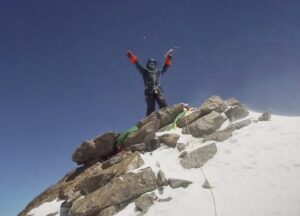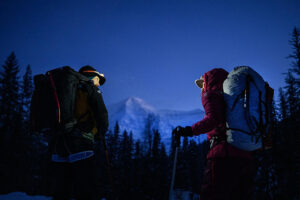Pumari Chhish East is a difficult secondary peak of 7,492m Pumari Chhish in Pakistan’s Shimshal Valley. It lies north of the Hispar Glacier, surrounded by several other 7,000m Karakoram giants. The region is a playground for the best alpine-style climbers, with many hard, technical routes.
On June 29, 2022, French mountain guides Jerome Sullivan, Victor Saucede, and Christophe Ogier made the first ascent of 6,850m Pumari Chhish East. They climbed alpine style via the south face and named their route “The Crystal Ship” (M7, 6b, A2, 1,600m).

Jerome Sullivan, Christophe Ogier, and Victor Saucede after the first ascent of Pumari Chhish East, Pakistan, June 2022. Photo: Christophe Ogier
A party led by Takao Sasaki of the Japan Hokkaido Alpine Association first climbed the main peak of Pumari Chhish via the north ridge on July 15 and 17, 1979.
Approximately one kilometre southeast of the main peak is the southeast summit (7,297m or 7,350m, depending on the source), called Pumari Chhish South. Yannick Graziani and Christian Trommsdorf of France first climbed this on June 12, 2007, after a six-day battle up the south face. But Pumari Chhish East remained unclimbed and had become a coveted prize for highly skilled alpine climbers.

The Pumari Chhish Massif. B: Pumari Chhish Main (7,492m); C: Pumari Chhish South (7,350m); D: Pumari Chhish East (6,850m). Photo: Doug Chabot
Earlier attempts on Pumari Chhish East
Before 2022, there had been three attempts to climb Pumari Chhish East.
In the autumn of 2007, Americans Pete Takeda and Steve Su ascended the left side of the south face. They endured intensely cold weather, which had hit the region for weeks. Without enough supplies and with difficulties finding bivouacs, they retreated from 5,900m.
Two years later, in the summer of 2009, Canadians Raphael Slawinski, Eamonn Walsh, and Ian Welsted set out to climb Pumari Chhish East. They first acclimatized with the first ascent of a previously unclimbed 5,900m peak that they called Rasool Sar.
Initially, they planned to climb Pumari Chhish East via its south ridge, like Takeda and Su. “But after we had wallowed in horrible snow on a few ridge climbs, the corniced south ridge lost some of its appeal,” Slawinski wrote later in The American Alpine Journal.
Instead, they made two attempts on the southeast face, but their highest point was the base of a headwall at 5,700m.

The southeast ridge of Pumari Chhish East showing camps and a high point of around 6,700m. Photo: Tom Livingstone
In the summer of 2021, Mathieu Maynadier of France and Tom Livingstone of the UK faced unstable weather when they first arrived to attempt the mountain’s southeast ridge. When a weather window finally came, they confronted difficult terrain, with mixed climbing and steep ice.
“Everything was buried under powder, making the ridge time-consuming,” recalled Livingstone after the climb. “We had to climb up, down, and around numerous large mushrooms and cornices.”
Eventually, although the forecast promised one more good day, they awoke to heavy snow, poor visibility, and strong winds. The pair retreated just 100 to 150 vertical metres below the summit. They only had to do one last section along the summit mushroom.

A very difficult traverse below the crest of the southeast ridge of Pumari Chhish East. Photo: Tom Livingstone
Finally, the first ascent
This summer, the French trio arrived in Pakistan, supported by the American Alpine Club’s Cutting Edge Grant.
Christophe Ogier, Victor Saucede, and Jerome Sullivan spent almost a month in base camp, waiting out heavy snowfall.
“By that time, we had spent many many hours looking at photos and debating possible lines,” wrote Sullivan in a detailed report to Planet Mountain after the climb. “We decided that the more obvious lines were too exposed to falling debris from the mushrooms high on the mountain and that only the steepest lines of the face would be protected.”
Then the weather improved, and it remained stable during their entire ascent.

The south faces of Pumari Chhish South (left) and East. The southeast ridge of Pumari Chhish forms its right skyline. The 2007 French ascent of Pumari Chhish South went up the left side of the south face. Photo: Tom Livingston/AAC
They started the climb on June 25 at 2 am, targeting a direct line up the south face. The south face has three steep granite prows, and its summit is crowned with gigantic snow mushrooms.
By the end of the day, they were finally on the wall. After three complicated days, a very steep system of cracks led them to the shoulder. They made some uncomfortable bivouacs but also a very spectacular one atop a snow mushroom.
“The pillar was very sustained, with 20-ish pitches of mixed climbing and usually some aid sections, thin cracks, and overhangs,” recalled Sullivan.
The major difficulty came just before the shoulder. “Three pitches around 6b on steep, at times overhanging, rock finally gave way to the shoulder. Here, a last bivy and 250m of easy terrain led us to the summit.”
Throughout the climb, they faced the fear that they would reach a dead end.

On the south face of Pumari Chhish East. Photo: Jerome Sullivan
They spent a lot of time cleaning the snow mushrooms. Finally, on the morning of June 29, 2022, they topped out. Their altimeter showed 6,820m.
“We named the line ‘The Crystal Ship’, as this great prow was the vessel that crystallized our desires during our time at base camp…It was also a great song that all three of us enjoyed,” wrote Sullivan.
This first ascent, after several serious earlier attempts, is a remarkable achievement on a difficult, highly technical peak. There are no easy routes on Pumari Chhish East. Knowledge, climbing skills, decision-making, strategy, style, endurance, all at altitude, put this climb at the top of our list of expeditions for the year.

Triumph on the summit of Pumari Chhish East. Photo: Jerome Sullivan






